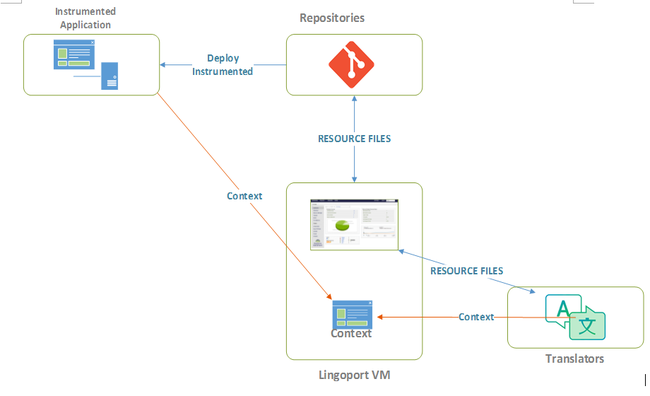Difference between revisions of "InContext Translation Installation"
(→InContext Integration with TMSs) |
|||
| (3 intermediate revisions by 2 users not shown) | |||
| Line 4: | Line 4: | ||
The InContext Translation process: |
The InContext Translation process: |
||
| − | #Base and target resource files are instrumented by |
+ | #Base and target resource files are instrumented by Localyzer and pushed to the code repository. |
#The instrumented resource files are deployed in a test build of the web application. |
#The instrumented resource files are deployed in a test build of the web application. |
||
#Using a Chrome browser extension, InContext Capture, the resource files and their context are captured and stored at the InContext Server (which may reside on the Lingoport Server). |
#Using a Chrome browser extension, InContext Capture, the resource files and their context are captured and stored at the InContext Server (which may reside on the Lingoport Server). |
||
| − | # |
+ | #Localyzer sends the resource files with their context to the TMS. |
=Installation= |
=Installation= |
||
InContext Translation is made up of three components that must be installed: |
InContext Translation is made up of three components that must be installed: |
||
| − | * [[ |
+ | * [[Localyzer Instrumentation | InContext Localyzer Instrumentation]] - The first thing to do is verify that you are using an Localyzer version and license for InContext Translation. |
* [[InContext_Server_Installation|InContext Server]] - InContext Server manages the resources identified by InContext Capture. |
* [[InContext_Server_Installation|InContext Server]] - InContext Server manages the resources identified by InContext Capture. |
||
* [[InContext_Capture_Installation|InContext Capture]] - InContext Capture uses a Chrome extension to identify application resources and send the text and context to the InContext Server. |
* [[InContext_Capture_Installation|InContext Capture]] - InContext Capture uses a Chrome extension to identify application resources and send the text and context to the InContext Server. |
||
=InContext Integration with TMSs= |
=InContext Integration with TMSs= |
||
| − | * |
+ | * [[Lingoport_InContext_Plugin_for_Trados_Studio | Lingoport InContext Plugin for Trados Studio]] |
Latest revision as of 20:31, 23 February 2021
Overview
The InContext Translation process:
- Base and target resource files are instrumented by Localyzer and pushed to the code repository.
- The instrumented resource files are deployed in a test build of the web application.
- Using a Chrome browser extension, InContext Capture, the resource files and their context are captured and stored at the InContext Server (which may reside on the Lingoport Server).
- Localyzer sends the resource files with their context to the TMS.
Installation
InContext Translation is made up of three components that must be installed:
- InContext Localyzer Instrumentation - The first thing to do is verify that you are using an Localyzer version and license for InContext Translation.
- InContext Server - InContext Server manages the resources identified by InContext Capture.
- InContext Capture - InContext Capture uses a Chrome extension to identify application resources and send the text and context to the InContext Server.
